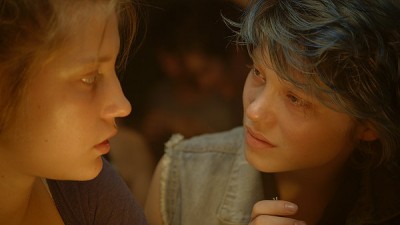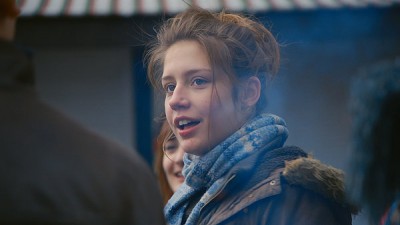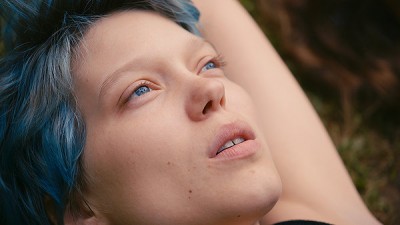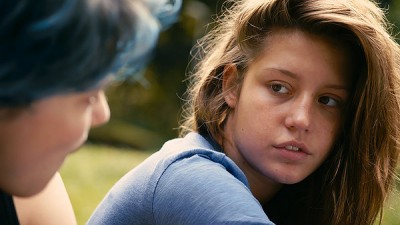| Reviews & Columns |
|
Reviews DVD TV on DVD Blu-ray 4K UHD International DVDs In Theaters Reviews by Studio Video Games Features Collector Series DVDs Easter Egg Database Interviews DVD Talk Radio Feature Articles Columns Anime Talk DVD Savant Horror DVDs The M.O.D. Squad Art House HD Talk Silent DVD
|
DVD Talk Forum |
|
|
| Resources |
|
DVD Price Search Customer Service #'s RCE Info Links |
|
Columns
|
|
|
Blue is the Warmest Color

The tumultuous fever of teenage love affairs is brought to vivid life in Blue is the Warmest Color, the sexy, emotional sensation of Cannes 2013.
Blue is the Warmest Color is based (somewhat loosely) on a graphic novel by Julie Maroh, who was just 19 when she began the comic. It has been adapted by Abdellatif Kechiche, a Tunisian filmmaker probably best known for The Secret of the Grain.
Adele Exarchopoulos, who can also currently be seen (albeit briefly) in I Used to Be Darker, stars as her namesake Adele, the protagonist of Maroh's narrative. At the start of the movie, Adele is 17 and studying literature in high school. Like most teen girls, she likes to sit around and gossip with her friends. Adele's peer group is particularly obsessed with boys, and Adele isn't entirely disinterested. On the contrary, she tries going out with an older classmate, but despite the mutual attraction, she finds that time alone with him leaves her feeling empty.

A couple of random encounters with attractive girls leads Adele to wonder if maybe the reason her dating life has stalled is she's not fully exploring her true sexuality. Her wanderings lead her to a lesbian bar, and the flirtatious blue-haired girl Adele has been fantasizing about since spotting her on the street. She is Emma (Lea Seydoux, Mission: Impossible - Ghost Protocol, Midnight in Paris), an art student several years Adele's senior. The attraction is mutual, and a long-term relationship begins between them--though one where Adele is arguably at a bit of a loss. Having less education and experience than Emma, she eventually feels both intellectually and emotionally deficient, leading to some bad choices that test the boundaries of their relationship and reveal the unhealthy depths of Adele's dependence on her lover.
Blue is the Warmest Color is an expansive, personal epic, at once raw and unadorned, but also highly stylized. Kechiche favors long scenes, letting conversations run their course, but he also likes cranks up the heat on any given moment. The emotional intensity of the story is tuned to Adele's appetites. She has the ability to be both childish and adventurous. Her desire is voracious, and that makes her sloppy. (Could someone please tell her to close her mouth when she eats?!) Exarchopoulos does a nice job of differentiating the character's different stages, with subtle shifts in wardrobe and make-up used to help show the passage of years. There is a nakedness to how the girl expresses herself--both in a literal and a metaphorical sense.

Indeed, much ado has been made over the lengthy, explicit sex scenes between Exarchopoulos and Seydoux. Just as with everything else, Kechiche lets these sequence go on far past the norm, and regardless of what choreography is at play, they look spontaneous and real. Skin gets flushed, sweat and spit exchanged--the temperature definitely goes up a couple of degrees in the theater. I suppose it's not surprising that many have turned their focus on this aspect of Blue is the Warmest Color--it's rated NC-17 for a reason--but the excess here is equal to the excess throughout, it is just as indicative of Adele's approach to life as the way she attacks her gyros on a misguided date with a boy in one of the film's earlier scenes. To spotlight the sex over the more palpable and surprising intensity of the girls' courtship/seduction is to miss the full emotional scope of the picture. It's in their first few interactions that Blue is the Warmest Color really caught me off guard, and also where Lea Seydoux really shines. The eye contact and flirtatious smiles meant for Adele end up trained on the camera, and thus shine through to the audience. The nervous excitement of early romance comes across in disarming ways. Their close conversations are far more intimate than the physical coupling.
Then again, that may be Kechiche's intention, given where the love affair goes and what, ultimately, we discover that the relationship is built on. Adele's lingering dependence on Emma, and the way she rouses her physical passion, threatening the older girl's more concrete interpersonal accomplishments, ends up being toxic for them both. And perhaps how we wish Emma would give Adele another chance should cause us to question our own emotional maturity.

Jamie S. Rich is a novelist and comic book writer. He is best known for his collaborations with Joelle Jones, including the hardboiled crime comic book You Have Killed Me, the challenging romance 12 Reasons Why I Love Her, and the 2007 prose novel Have You Seen the Horizon Lately?, for which Jones did the cover. All three were published by Oni Press. His most recent projects include the futuristic romance A Boy and a Girl with Natalie Nourigat; Archer Coe and the Thousand Natural Shocks, a loopy crime tale drawn by Dan Christensen; and the horror miniseries Madame Frankenstein, a collaboration with Megan Levens. Follow Rich's blog at Confessions123.com.
|
| Popular Reviews |
| Sponsored Links |
|
|
| Sponsored Links |
|
|
| Release List | Reviews | Shop | Newsletter | Forum | DVD Giveaways | Blu-Ray | Advertise |
|
Copyright 2024 DVDTalk.com All Rights Reserved. Legal Info, Privacy Policy, Terms of Use,
Manage Preferences,
Your Privacy Choices | |||||||











